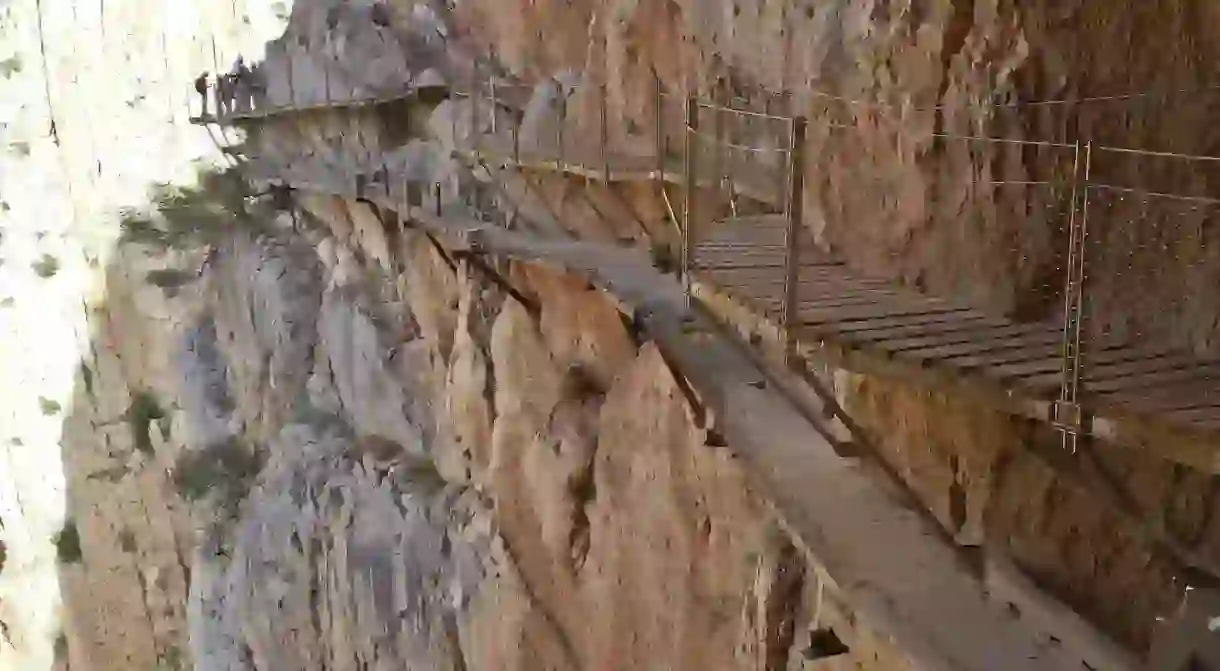El Caminito Del Rey: How to Survive the World's Deadliest Pathway

You should think carefully about watching one of the many YouTube videos of fearless (read: unhinged) hikers walking the old Caminito Del Rey before you tackle it yourself. This three-feet wide pathway, pinned to one side of a deep gorge more than 300 feet above the river below, was built between 1901-1905 to connect the two hydroelectric plants in El Chorro, a beautiful part of Málaga province.
It gradually deteriorated through lack of use and was finally shut by local councils in 2000. The only safety measure in place before the Caminito’s re-opening in March 2015 – after a stunning €2.7million renovation financed by the governments of Málaga and Andalusia – was a thin, steel safety wire running along the cliff-face. Those wanting to attempt what had become known as the “world’s scariest hike” attached themselves to this and, presumably, hoped they wouldn’t have to test its strength.

Mortal risk is not something to worry about on the new Caminito, which runs just above the route of the original pathway, parts of which which are still terrifyingly visible beneath your feet. But if you’re bothered by heights in any way, it’s probably better you go nowhere near YouTube before heading to El Chorro.

In total, the Caminito is a 4.78 mile route (tickets cost just €10). For convenience, park at the walk’s southern end and get the shuttle bus (every half hour, €1.55) to the northern access point near Ardales. Here, after alighting from the bus, a 1.5 mile trek through pine-scented countryside bordering turquoise lakes brings you to you the entrance of the Caminito proper. Friendly staff check tickets, organize walkers into groups of about 30–40 and issue everybody with mandatory hardhats. When you get this far, there’s no going back. As you step onto the first section of cliffside walkway, a nasty little sign reminds you to take care and to go slow because “some sections are high-risk.” Wait a minute – weren’t they supposed to have made it risk-free?
There are two sections on the cliffside walkway itself, separated by a 1.25 mile stretch of pathway through more of El Chorro’s stunning fauna and woodland. The walk will take you about two-and-a-half hours in total – or less if fear powers you over the route in an acrophobic, adrenaline-fuelled scurry. At the end, where you regain your car, there is a bar with a terrace overlooking those cinematic lakes. Whatever you take as refreshment here will never have tasted so good.

The Caminito’s hair-raising finale is the stretch of cliffside pathway that starts about half a mile before the walk’s end. This far into the trek, you’ll have adjusted to the awesome dimensions of height and space that engulf you. But only when flying in dreams will you have experienced the kind of vertiginous beauty that surrounds you on the Caminito’s finale. Winding around the sheerest cliffs of El Chorro, it culminates in a swaying suspension bridge that crosses the deepest part of the gorge, followed by a breathtaking home-straight with steep steps at regular intervals. And guess what: it’s impossible to negotiate these steps without looking straight down.
The corners on this stretch of the walk play weird, unsettling games with your mind and internal orientation systems. Looking ahead of you, the path frequently curves out of sight at almost 90 degrees: it appears as if the Caminito has abruptly terminated, leaving you stranded against the cliffside. Nothingness, just a few metres away, with the gorge awaiting your final step off the planks.

Then there are the elements, to which you are mercislessly exposed. The wind up on the Caminito’s final stretch, even on the stillest of days down on Earth, can be ferocious. It gusts and howls around the gorge, enabling the birds to glide a couple of hundred feet below you, inducing a sense of insignificance and vulnerability.
It was a masterstroke of Luis Machuca’s, head architect and director of the project, to retain the style of the original Caminito, rather than making it more substantial or covering it. Indeed, looking at what remains of the original path beneath your feet – scarred with gigantic holes and solely comprised in places of emaciated steel girders – gives you a new order of respect for the workers who used to have to walk it all day, every day. Machuca’s superb renovation makes you feel as they presumably did: vulnerable and small, utterly exposed to nature’s indifference – and so goddamn high up.













